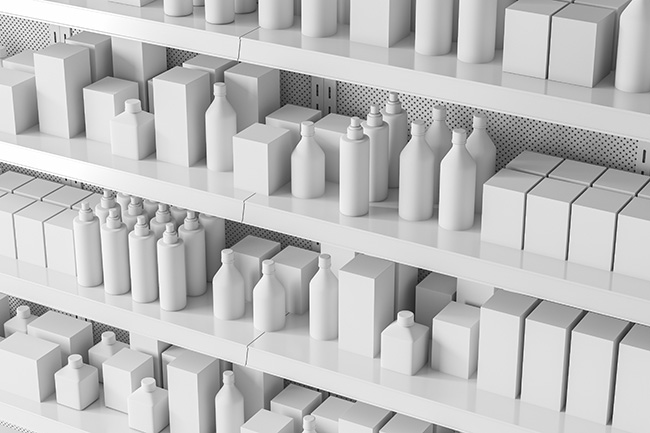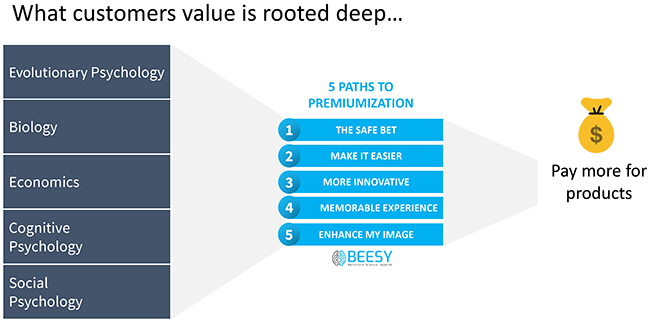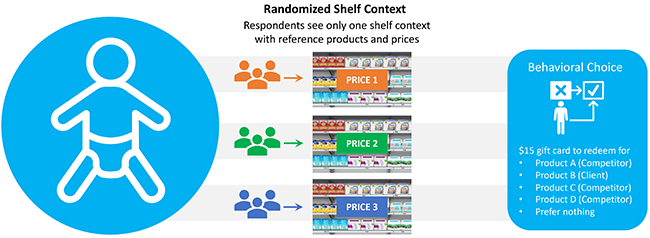In the eye of the beholder
Editor's note: Jason Martuscello is a business strategist with New York behavioral science firm BEESY.
 How much would you pay for water? Would you pay more if the water was bottled? What if it had an artistic label on it? While very few people admit they would pay for water, many do. Asking questions about willingness to pay is deeply flawed but still commonplace in pricing decisions. Not only do people pay for water – which is freely available to most households – but they pay two to five times more for premium variants of water. LIFEWTR, Fiji, smartwater, Essentia – these are just some of the brands that took freely available water and captured premium margins through understanding how customers perceive value.
How much would you pay for water? Would you pay more if the water was bottled? What if it had an artistic label on it? While very few people admit they would pay for water, many do. Asking questions about willingness to pay is deeply flawed but still commonplace in pricing decisions. Not only do people pay for water – which is freely available to most households – but they pay two to five times more for premium variants of water. LIFEWTR, Fiji, smartwater, Essentia – these are just some of the brands that took freely available water and captured premium margins through understanding how customers perceive value.
This article will unravel the traditional practices of value creation and provide a new way to approach the pricing function through premiumization. We will help provide a framework to price products that bends the traditional rules of pricing and enables you to capture premiums.
Problems and issues
Current pricing practices face several problems and issues.
Letting economics inform pricing and consumer behavior. (Solution: integrate behavioral economics.) Classical economics assumes purchase decisions are grounded in rational decision-making and it advocates for maxims such as “consumers maximize purchase utility” or “price increases equal volume reductions.” Behavioral economics, in contrast, has discovered key limitations when applying rational economics to complex human behavior. For example, Nike not only raised its prices but increased customer demand; Nabisco charged more for less when it introduced the 100-calorie snack packs. Relying on economics to make pricing decisions without understanding behavior only leaves margins on the table.
Overreliance on price elasticity and willingness-to-pay methods. (Solution: integrate context factors into methods.) Relying on price elasticity – the measure of the sensitivity of demand to changes in price – can result in a missed opportunity to recognize when consumers will pay more for brands and products. In classical economic models, price elasticity relies purely on direct, stated measures of willingness to pay and fails to account for the social, emotional and contextual drivers of purchase. It will never be able to identify when customers will pay a premium.
Objective vs. perceived value. (Solution: Remember that value is perceived.) While we know customers pay for value, we rarely create, design, innovate or quantify how customers perceive value. To fully account for the value customers perceive, we must incorporate the influences that drive value perception. Historically, these have relied on basic quality and tangible benefits but the success of premiumization proves value is beyond the rational, tangible benefits. Rather, it is rooted deep in fundamental psychological needs.
Pricing is not in a vacuum. (Solution: Remember that pricing is dynamic.) Consumers rarely have a predefined price they are willing to pay; instead, they often develop and arrive at a sufficiently acceptable price throughout the decision-making process. Pricing strategies should thus not only try to predetermine willingness to pay but should also aggressively focus on identifying any means that can enlarge consumers’ price acceptance, broadening the lens of value by utilizing the five paths to premiumization.
Restrictive view
The lens for value creation and price-setting has been limited by the restrictive view of economic benefits added. Getting customers to pay premium has been assumed to be equivalent to innovation – adding product features and benefits – and so companies will charge more for their products by spending more. But what if we can add value to products without driving up costs? This is the focus of premiumization.
Premiumization is the process of getting customers to pay more for brands and products. It strives to increase customers’ perception of value without ramping up costs by adding tons of benefits or new features. Premiumization is all about contribution margin – earning more money per unit of product sold – and so the starting point should be prioritizing low-cost, least-effort changes to add perceived value and command margin increases.
Figure 1

There are implicit reasons consumers will pay more for brands (Figure 1).
- Evolutionary psychology and the safe bet. We have an evolutionary need to have reliable experiences and feel safe with our purchases. Consumers will pay more to feel a product is reliable and safe. Whether it’s the comfort of the Marriott stay, the absorption of Bounty or precision of Gillette, these are brands that are the safe bet. If you elevate your history and legacy of serving customers, consumers will find the increased price worth the peace of mind.
- Biology and making it easier. It’s built into our biology to conserve energy and it turns out that consumers will also pay more to expend less energy. Uber reduces walking, Amazon reduces clicks and Apple reduces the steps to unlock your phone. Elevating your brand’s ease with choosing and using can be a significant premiumization driver.
- Economics and innovation. Human beings are continuously reinventing the world around them by adding, changing, innovating and improving. As brands and products advance, people advance. Tide removes stains better, Nike shoes help us run faster and products that never existed actually enhance our lives. Innovation is a direct route to charging more. However, the focus to premiumize with innovation is to add perceived value without layering on costs.
- Cognitive psychology and pleasure. The psychological sciences have demonstrated our need for pleasure and when the opportunity arises, people will even pay for it. Brands that go beyond mere function and the job to be done to create an emotionally charged experience can reap the additional rewards of premiumization.
- Social psychology and enhanced image. We have a social need to not only fit in but also stand out amongst our peers and so consumers will pay more to look good. Brands that help signal their customers’ higher social status when using their products simply can charge more. This is not just restricted to clothes and cars; anything that is visible and can be seen is fair game. The water bottle people see in my hand, the dish soap people see on my counter – all can unlock price increases.
Key insight: Premiumization bends the traditional rules of pricing by broadening the concept of value. To unlock, first identify untapped paths to premiumization for your products that consumers value, especially those your competition has not yet identified. Next, position your product along the value dimension.
Comparison to an alternative
One of the most robust findings in behavioral science is that consumers use reference points in making choices. A reference price, an internal standard against which observed prices are compared, is the basis for which value is perceived. Something is only expensive, cheap or “worth it” in comparison to an alternative. For example, a Heineken may be expensive if I compare it to a Bud Light or Pabst Blue Ribbon but Heineken may be cheap if purchased at a Walmart compared to a Ritz-Carlton.
What is interesting about reference points is that they are unstable, dynamically shifting based on the situation and context and they can be quantified and influenced. Reference architecture deliberately influences reference points (points of comparison) to drive premiumization. There are four broad ways to architect and influence reference points:
Change positioning. Value perception is centrally linked to the product offering, which means better products are perceived to be of high value. By changing the positioning, we can alter the reference for value perception. Many legacy brands have trusted-and-loved products but could use a more relevant positioning to drive price premiums. Colgate, for instance, is positioning its brand and products along the sustainability trend to drive premium prices; Campbell Soup is shifting from preservative-laden to a premium and healthy home-cooking alternative to command higher prices.
What premium positioning can command a higher price point?
Change packaging. The visual appearance of a product is the dominant sensory reference point for comparisons. Among a category of choices, the features of the package (shape, size, label, contour, text, symmetry) convey the value proposition. How can we make the label drive the value of the product category? Kind Bars, for example, added the transparent window to give consumers a preview of what they buy.
What package designs can command a higher price point?
Change context. When I moved from Miami to New York City, paying twice the amount for rent became normal. The same goes for our in-store products on shelves and in e-commerce. The context or location creates the reference prices that influence willingness to pay. A cleaner sold at Walmart as opposed to Whole Foods will have different reference points and hence prices. Aerosols are moving from the air care aisle to home décor to more easily command premiums as average selling prices in this category as a whole are higher.
Which premium location can command a higher price point (new store, new aisle, higher shelf, middle shelf, online)?
Change comparisons. Left to their own devices, consumers will typically compare with their past purchases or with what’s in the immediate environment. However, brands can proactively encourage new and more expensive comparisons to premiumize and get customers to pay more. “It’s not delivery. It’s DiGiorno.” makes the price of frozen pizza look like a bargain compared to delivery pizza; Nespresso may be expensive compared to other brands but next to Starbucks, it’s cheap.
Which premium comparisons can we seed to command a higher price point?
Key insight: To bend the rules of pricing, we must change the reference points to enhance the willingness of customers to pay more for your products. Reference points are not static comparisons to competitors’ prices but are constantly evolving based on the situational context and decision dynamics. By architecting the reference points, we can drive a higher willingness to pay.
What comparisons can we use to make the product be perceived as more valuable?
Optimize premiumization potential
Classic pricing research, such as conjoint analysis and willingness-to-pay experiments, typically forces consumers’ attention to a price, which is not representative of the real world. Premiumization pricing research, based on actual decision-making, replicates the real-world decision context to optimize premiumization potential. Simply put, we are looking to identify what optimizes customers willingness to pay.
Let’s look at two aspects of premiumization testing.
The key distinction of premiumization testing is it is experimental (randomized, monadic design) and strategically implements reference scenarios consumers use to make decisions that can drive a higher willingness to pay. Testing in context brings in reference prices to understand the decision dynamics that can influence these higher premiums. We can break down the premiumization potential methodology into two components: independent variables and dependent variables.
Independent variables – randomized in-context experimental research design. Consumers are randomly assigned to a shelf set with product placed within the purchase context as well as competitors and prices. Each shelf set is typically identical except for price changes. By having each consumer randomized to only one shelf set, we enable the ability to compare between shelf sets to see which price drives highest choice share.
Behavioral choice dependent variable. By using a behavioral choice lottery where respondents have the opportunity to win their actual choice, we can create a scenario in which they have a skin in the game while providing a more realistic proxy for purchasing behavior. The lottery choice process involves realistic choice options including the competitors and options to not choose.
Let’s look at an example.
A new product was recently introduced to the market that helps prevent the risk of babies developing food allergies. We were interested in understanding the best retail location to drive adoption and command a premium price tag. We developed shelf sets for each specific location that we were considering placing the product in retail (food, formula, supplement) and included competitor products and prices. We produced the three shelf sets (Figure 2) with the products at two different price points – $19.99 and $24.99. (Three locations + two price points = six conditions tested.)
Figure 2

When we compared the behavioral choice of the new product between the six conditions, we identified the shelf location and price point that optimized choice share and profit. Interestingly, the higher price point actually drove a larger choice share. Premiumization testing ultimately helped identify the retail location to drive the largest trial (penetration) and command the highest price (premiumization).
Bends the rules of pricing
The classic approaches to managing and setting prices have limited the growth and competitiveness of brands. Premiumization, the process of getting customers to pay more for brands and products, bends the traditional rules of pricing by understanding the underlying psychology of why customers are willing to pay premiums. By implementing the five paths to premiumization – the safe bet; make it easier; more innovation; memorable experience; and enhance image – brands can enlarge customers’ perceived value without driving up costs.
Instead of reactively setting prices based on outdated conjoint analyses or asking customers their willingness to pay, start proactively identifying mechanisms to drive price premiums in your categories. The key to growth with premiumization is not following the textbook rules of pricing but rather knowing the exceptions to the rules which will help get brands ahead.
